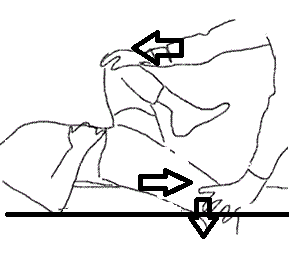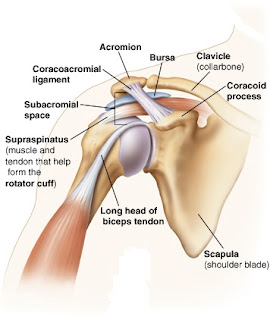TESTS FOR SACROILIAC JOINT DYSFYNCTION
·
PROVOCATION
TESTS
1. GAENSLEN’S TEST:
The gaenslen’s test stresses the sacroiliac joint, increased pain on the
joint while performing the test is indicative of the sacroiliac joint
dysfunction.
-
The patient in lying on the couch in a side
lying position with the affected leg hyperextended (hanging outside the couch).
Patient flexes the other leg and holds knee to chest. The therapist stabilizes
the pelvis while the extending the hip by holding it from distal thigh. The pain
in the sacroiliac joint may be caused due to a sacroiliac joint pathology,
lesion or dysfunction.
-
The patient is lying supine (this position limits
the amount of hyperextension at the hip) the affected leg is hanging out of the
couch, the therapist puts one hand on the hyperextended leg from distal thigh
and the other hand on the flexed knee of the opposite leg and apply pressure to
both the legs (a downwards pressure on the hyperextended limb and a knee to
chest pressure on the flexed knee).
Pain in the sacroiliac joint is indicative of the sacroiliac joint
dysfunction.
2. FABER’S TEST:
The patient is in a supine lying position and asked to make a figure of 4
with the affected limb causing the movements of flexion abduction and external
rotation on the affected leg with ankle resting on the thigh of the unaffected
leg. The therapist palpates the anterior superior iliac spine (ASIS) of the
opposite side and stabilizes it. On the affected leg, the therapist applies a
pressure on the knee in a downwards direction.
If the patient complaints of pain while performing the test, the test
comes out to be positive.
3. THIGH THRUST TEST:
The patient is in a supine lying position, with hip and knee flexed to 90
degrees.
The therapist place one hand under the pelvis on the sacroiliac joint and
with the other hand applies a posterior shearing force (downwards) on the knee.
The pain on applying force on the knee is indicative of a positive thigh
thrust test.
4. COMPRESSION TEST:
-The patient is in a side lying position, the therapist palpates the
anterior superior iliac spine (ASIS) at the pelvis and applies a force
downwards.
-The patient is in prone lying position, the therapist applies pressure directly to the sacroiliac joint.
Pain caused at the sacroiliac joint on applying force is indicative of a
positive compression test.
5. DISTRACTION TEST:
The patient is in a supine lying position, the therapist palpates the
anterior superior iliac spine (ASIS) of both the sides of the pelvis and
applies a pressure outwards.
Pain provoked while performing distraction is indicative of a positive
distraction test.
·
NEUROLOGICAL
INVOLVEMENT TEST
STRAIGHT LEG RAISE (LASEGUE’S TEST):
The SLR is a primary test for lumbar spine neurological test
but also plays an important role on the sacroiliac joint. The patient is in a supine
lying position and the therapist passively flexes the leg with knee extended. Pain
occurring at 70 degrees and after are indicative of the joint pain, but in
patients with a hyper mobility of the joint pain is observed an 120 degrees and
above. It is necessary to test both the limbs. PAIN OCCURRING BEFORE 70 DEGREES
OF HIP FLEXION I INDICATIVE OF THE SACROILIAC JOINT PATHOLOGY.
REFERENCE
Orthopedic Physical Assessment, David J. Magee, Fourth Edition.








Comments